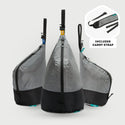For 60 years America’s relationship with Cuba has been fraught to say the least. But can Americans travel there legally and, if so, what are the hoops to jump through in order to enjoy that Daiquiri like Hemingway in Havana?

Back in 1958, a severe trade embargo by the US on the upstart communist island began as a result of US oil interests being nationalised without compensation. Then there was the Cuban missile crisis that brought us to the brink of nuclear war with the Soviets. On the surface, Cuba has barely changed. We know they have cigars and classic cars held together with sellotape, but there is so much more to Cuba that makes Americans long to travel to this mysterious land that is apparently trapped in the middle of the 20th century. Three years after Fidel Castro’s passing, we ask is it legal for Americans to head there for a vacation? And, if so, what steps do we have to take and what can we expect when we get there?
Cuban American Relations

Just before the revolution that thrust Fidel Castro into power, the American mob was fast creating a party island out of Cuba, taking over hotels and gambling concessions but more importantly, they were importing hundreds of big American cars. When President Fulgencia Batista fell, leaving the way open for Castro, the mob fled, leaving their beautiful big cars behind them.
The US hated Castro for his communist links and immediately imposed a trade embargo which has remained ever since.
There was also the 1962 Cuban Missile Crisis, when Castro allowed the Russians to place missiles on their soil. US President John F Kennedy wasn't having it. We were taken to the brink. The Russians backed down and the threat of a nuclear war was averted.
American Tourism To Cuba In The 21st Century

Since the first commercial airline flight in August 2016, more than 2.2 million people have flown from the United States to Cuba, and hundreds of thousands more have disembarked in port cities such as Havana, Cienfuegos, and Santiago from massive cruise liners that arrived daily in Cuban harbors.
However, President Trump banned cruise liners from docking in Cuba in June of this year. The administration also abolished people-to-people tours, through which tens of thousands of US citizens have ventured to the island for a unique educational experience. Simultaneously, the State Department expanded its so-called “Cuba Restricted List”—over 200 hotels, restaurants, shops, businesses, rum distilleries, and other official entities administered by the Cuban military where US travelers are prohibited from spending money.
However, this doesn’t mean Americans can't travel to Cuba. In fact, it is still 100% legal to do so.
You Can Travel to Cuba Legally with a US Passport

But you can no longer travel to Cuba under what was known as the People to People category, which was primarily used by guided tour companies and cruise lines. You can still travel to Cuba, 100% legally, under what is known as the “Support for the Cuban People” category. The bottom line here is that airlines are still flying to Cuba, and it is still 100% legal to travel there.
Categories Under Which Americans Can Travel To Cuba

Every American traveler to Cuba must choose an approved category of travel. This is a US government requirement. The category you choose and report depends on how you're going to spend your time in Cuba.
American cruise ships can no longer go to Cuba. As a result of no longer being able to book trips to Cuba under the People to People travel category, the ability to take guided tour packages and cruises to Cuba has been removed. American cruise ships are no longer able to dock in Cuba.
There are 11 remaining categories – down from the 12 that existed prior to June, this year.
- Family Visits
- Official Business for the US Government, Foreign Government, and Certain Intergovernmental Organizations
- Journalism
- Professional Research
- Religious Activities
- Public Performances
- Support for the Cuban People
- Humanitarian Projects
- Activities of Private Foundations for Research or Educational Institutes
- Exportation, Importation or Transmission of Information or Informational Materials
- Certain Export Transactions
Support for the Cuban People is meant to enable travelers to support the Cuban populace. It is used by independent travelers to Cuba. You can go on your own as long as you follow the guidelines for the category.
Your trip will fit into the Support for the Cuban People category if you:
- Support independent activities that could strengthen civil society in Cuba.
- Avoid all GAESA-owned (military-owned) businesses. You cannot spend money or interact with any of them.
- Engage in "Support for the Cuban People" activities consistent with a “full-time schedule.” Much like when you’re working, you have to follow the rules during your full-time schedule, but you’re more free to choose your activities outside of that full-time obligation. Support for the Cuban People activities include:
- Meeting with local artists, musicians, tobacco manufacturers, farmers, and others who own their own businesses.
- Shopping in independent markets.
- Exploring independently run museums.
- Taking classes on subjects like dancing, traditional music, and Spanish language.
- Talking with musicians at a live music venue.
- Attending art shows and learning about different Cuban artists.
- Discussing Cuban society with locals like your casa particular host or people you meet while out and about.
Documentation

Make sure you keep your receipts for five years after your trip. Keep important documents in a safe place when you get home. Have an itinerary which makes it easy to show that you filled your schedule with appropriate activities should you ever be asked.
Classic Cars Are Part Of The Charm

For those who are lucky enough to see Cuba in the flesh it is really a case of driving back in time.
If you’re smart, you'll want to arrange a classic car ride from Havana's Jose Marti airport to your hotel to start your trip in style.
As you roar along the roads, your nostrils are filled with the gasoline fumes of other fifties Chevrolets and Cadillacs passing alongside and flanked by dusty and decrepit buildings.
Because far from seeing the occasional Chevy taxi on the streets, Cuba is positively swarming with brightly painted vintage cars - some of them are admittedly rust buckets held together by glue and duct tape - but others are pristine and sparkling as though they've just rolled off a secret production line. Car lovers could never tire of the sight of these Oldsmobiles, the aforementioned Chevrolets and Cadillacs as well as Buick Specials, Chrysler Plymouths, Studebakers and the distinctive Ford Thunderbirds that litter the streets of Havana and smaller cities such as Vinales, Trinidad and Cienfuegos.
But if you're a fan of these classics, you may want to visit... before they fall apart.
For a long time the Cubans could not import any new cars but instead had to make do and maintain what they were left with.
There’s no doubt that car lovers will need to get their skates on if they want to see old Cuba complete with its incredible working museum of old school American brand vehicles. In the US, a restored 1957 Chevrolet Bel Air might fetch over £100,000.
No wonder Cuba has more layman mechanics per capita than any other country in the world and it's not unusual to see a clapped out classic car propped against a tree or laying derelict in a city square.
Sadly for Cubans, there doesn't appear to be a clean air act and while on a wander along the streets of Havana, you can expect to see clouds of smoke belching from cars as they hit their stride.
But even that can't take the shine off the thrill of seeing these beautiful beasts in what has been described as the Jurassic Park of classic cars.
It feels like the Sharks and the Jets could break into a West Side Story dance routine at any moment.
Other Things To See And Do

There are plenty of things to see and do in Havana and cities like Cienfuegos, Trinidad - where old men dance in the square with the ladies – as well as all-inclusive beach resorts like Varadero where the Canadians announce their nationality with maple leaf t-shirts. Clearly, they're trying to avoid being mistaken for Americans.
Horse riding and tobacco farms are worth a visit. At the latter you'll see how the world famous cigars are rolled and you'll be given the chance to try one.
You can also visit the famous author Ernest Hemingway’s Havana retreat, wandering the beautiful grounds and seeing the home in its preserved state including original art and furniture.
Money

One final thing to bear in mind about Cuba is that there are two currencies, one for Cubans and one for tourists. The CUC or Peso Convertible, worth about a dollar, and the Moneda Nacional, whose conversion rate is 25 to a CUC.
But yes, you can go to Cuba... though nobody said it was going to be easy.











